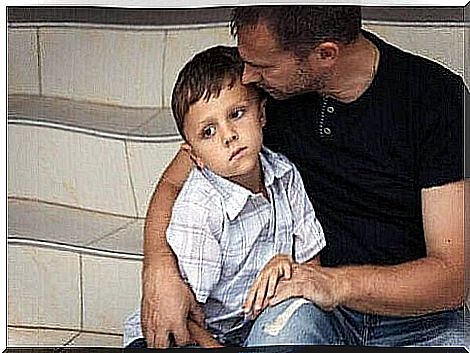Four Subtle Forms Of Mental Abuse

Subtle forms of psychological abuse are often difficult to identify. They can be dangerous due to the seemingly harmless nature. However, this type of behavior gradually undermines the victims and leaves emotional pain. So what are the subtle forms of mental abuse?
Today’s article will discuss four subtle forms of abuse that can occur in any context. You will also learn about the signs that can help you identify them, and pay special attention to the consequences for the victims.
The subtle forms of psychological abuse
It is common to refer to the most obvious forms of psychological abuse. However, the subtle forms are often hidden, ambiguous, and thus people can be more generous in their interpretation of an aggressor’s intentions. Thus, people often think that the attacker will help.
Research suggests that subtle forms of abuse are much more common than others that give clearer signs, such as physical abuse. However, the damage from these subtle forms of abuse can go deeper in the long run.

The difficulty of identifying the aggression, the repressed emotions and the silence they give, does not lead to intervention until later. Therefore, it becomes more difficult to get out of a situation or reverse it.
The subtle forms of psychological abuse can come in the form of “harmless” comments. Others come as condescending or humiliating, in addition to blackmailing and trying to control you. This type of aggression can occur in different contexts, such as in a romantic relationship, parents and children, and even in other types of bonds such as friendships.
One of the characteristics of these subtle forms of abuse is that they generate specific feelings and experiences in the victim. In general, they make them feel that they are not worthy of love, guilty in many situations, and they may even develop a strong ignorance of their own well-being.
The quiet treatment
This is a subtle form of abuse. The plot aims to ignore the victim by not talking to them and behaving as if they are not even there. This is covert blackmail, and the attacker does not stop being indifferent until the other person gives in to what they want.
The quiet treatment reveals the emotional immaturity and poor communication skills of the attacker. The consequences for the victim can be quite damaging. Being ignored leads to feelings of fear, sadness, anger and above all anxiety. The victim blames himself for the situation; they do not understand why they are being treated this way.
2. Subtle forms of mental abuse: Gaslighting
Gaslighting, like the popular Hollywood movie of the same name, is one of the most subtle forms of abuse. The main characteristic is that the abuser makes the victim doubt his own judgment and even his own perception or recollection of certain events.
In this form of blackmail, the attacker refers to the fact that the victim has imagined or exaggerated certain situations they have experienced, either consciously or unconsciously. Thus, the victim will stop defending their position in an argument when they begin to doubt whether things really happened the way they remember them. This situation is usually repeated over time and damages the victim’s self-esteem. They end up in a situation of extreme vulnerability to the attacker.
The consequences of these subtle forms of abuse include strong feelings of dependence, feelings of depersonalization and loss of control. Victims of gaslighting often report the feeling of going crazy or losing control of their lives.
3. Overprotection
This has nothing to do with protecting. In fact, the care offered has a limiting effect on victims in these subtle forms of abuse. In other words, this protection is detrimental to the victim’s autonomy and is a negligent form of parental behavior.
Overprotection comes in many forms. From low capacity to setting clear boundaries to veto the victim’s initiatives, or avoid any kind of frustration at any cost. The consequences of these actions create the feeling of fear in a person, dependence on the attacker and low tolerance for frustration. As you can imagine, it limits the victim’s daily life.
4. The loyalty conflict
This is one of the subtle forms of abuse that can occur in various contexts. However , there are usually divorced couples with joint children. Some divorced parents do their best to gain the child’s unconditional loyalty. Of course, loyalty to one means disloyalty to the other.
It is common for parents to devalue the other person’s character in front of their children, place the child in the role of judge or make them feel guilty about enjoying the other parent.
The consequences of this type of abuse in children are associated with anxiety, somatization and can severely compromise emotional stability.

Subtle forms of abuse, a little at a time
Subtle forms of abuse are characterized by ambiguity. However, they are more common than other more notorious types of abuse. So they can lead to harmful effects on a victim in the long run. These conditions can worsen the prognosis for a victim.
The silent treatment is based on behaviors aimed at ignoring the victim in order to manipulate the behavior. Similarly, gaslighting reduces a person’s self-esteem. These subtle forms of abuse, which are common in romantic relationships, lead to fear, anger and anxiety in the victims.
Overprotection and loyalty conflicts are more common in parent-child family contexts. Parents create protective behaviors that limit their children’s autonomy and make them feel helpless. This type of abuse is usually committed by parents who force children to choose their side.
Subtle forms of abuse are like the drops that fall repeatedly on a rock. In other words, it is a collection of small things. They would not cause injury alone, but can do a lot of damage when maintained over time.
The greatest danger with these corrosive formulas lies in the difficulty of identifying them. Therefore, information is one of the most important things to prevent them.









